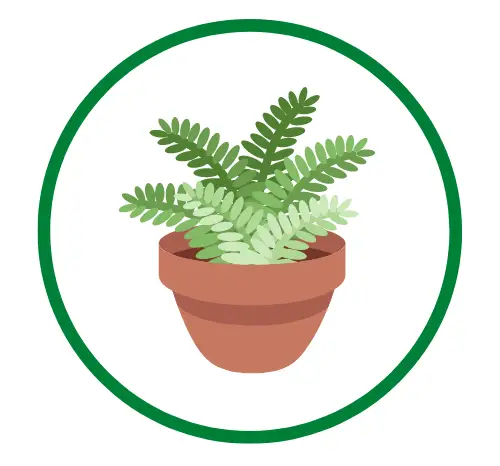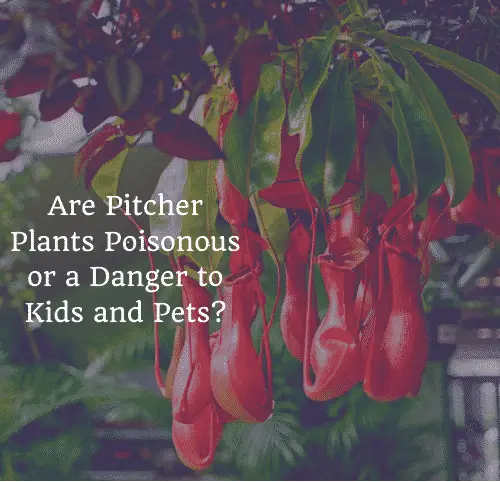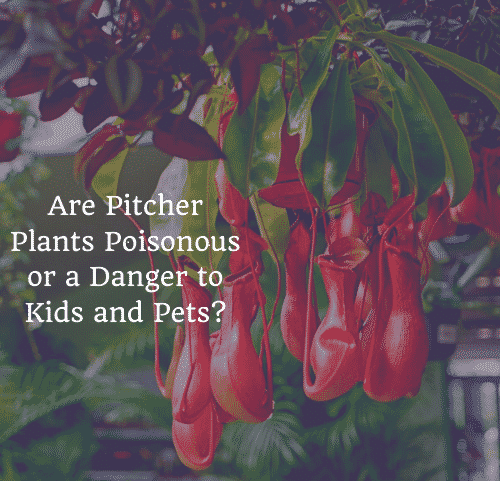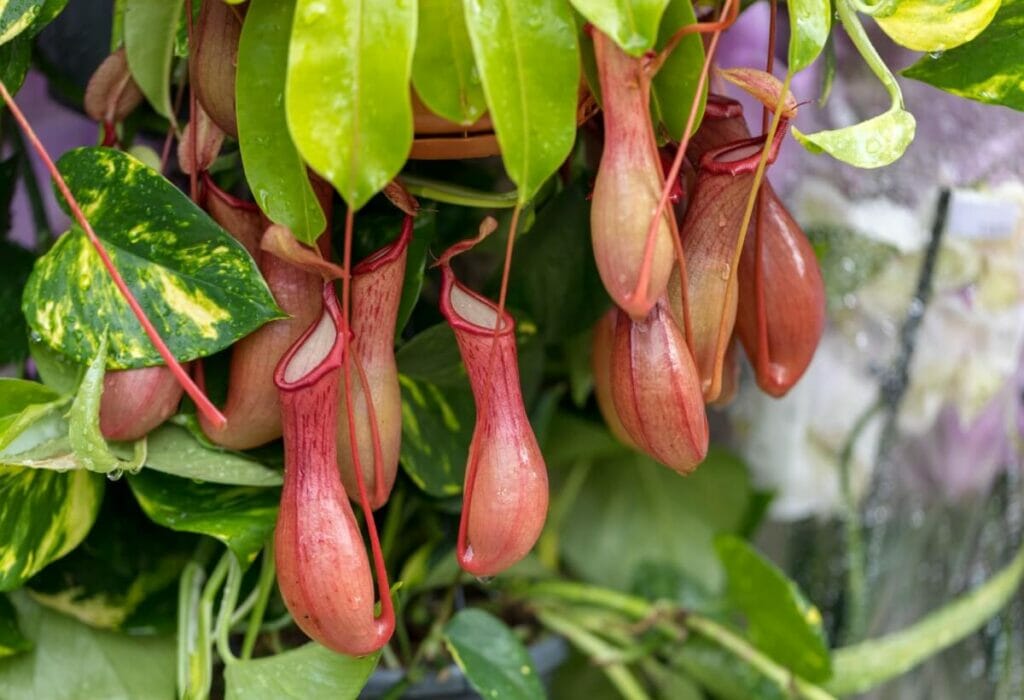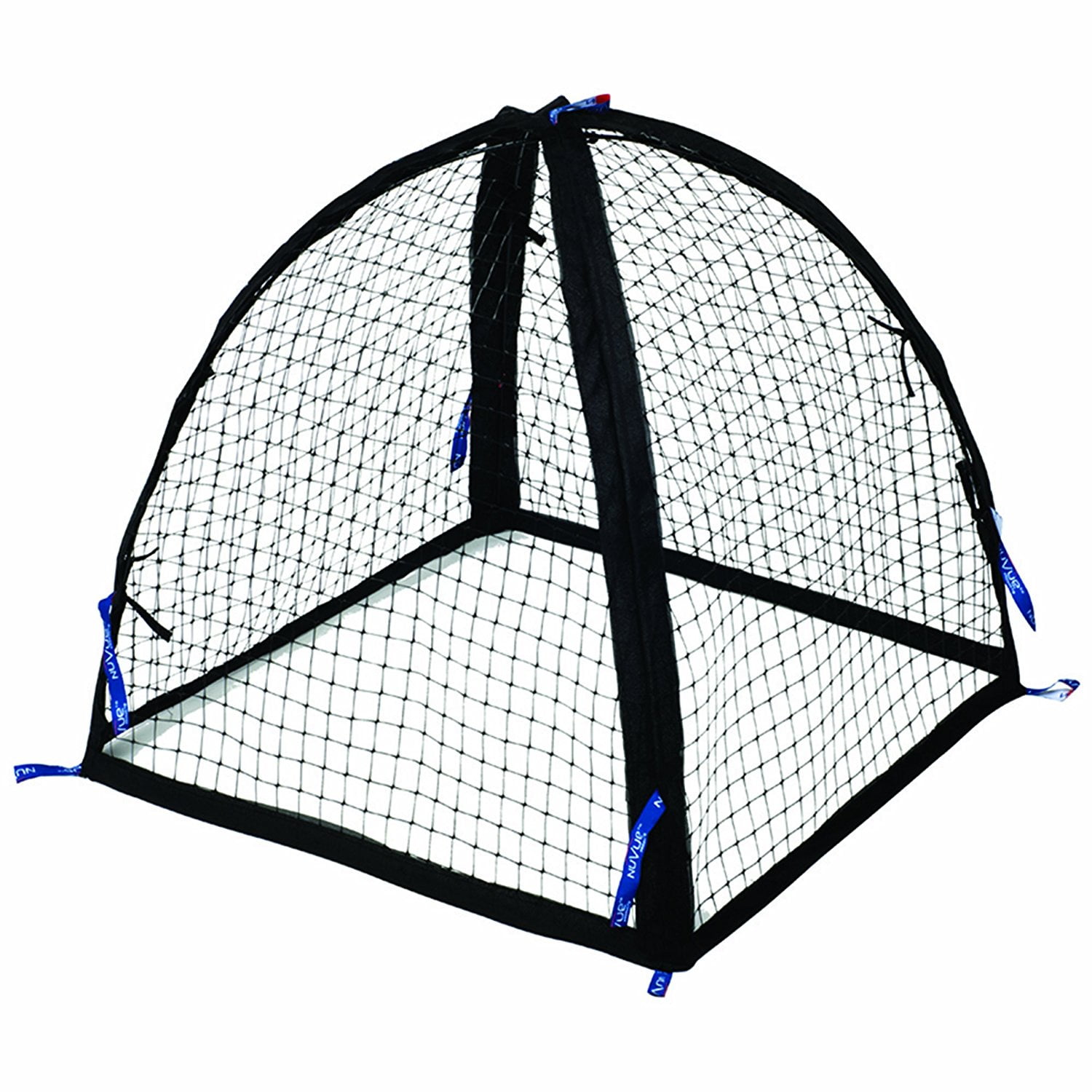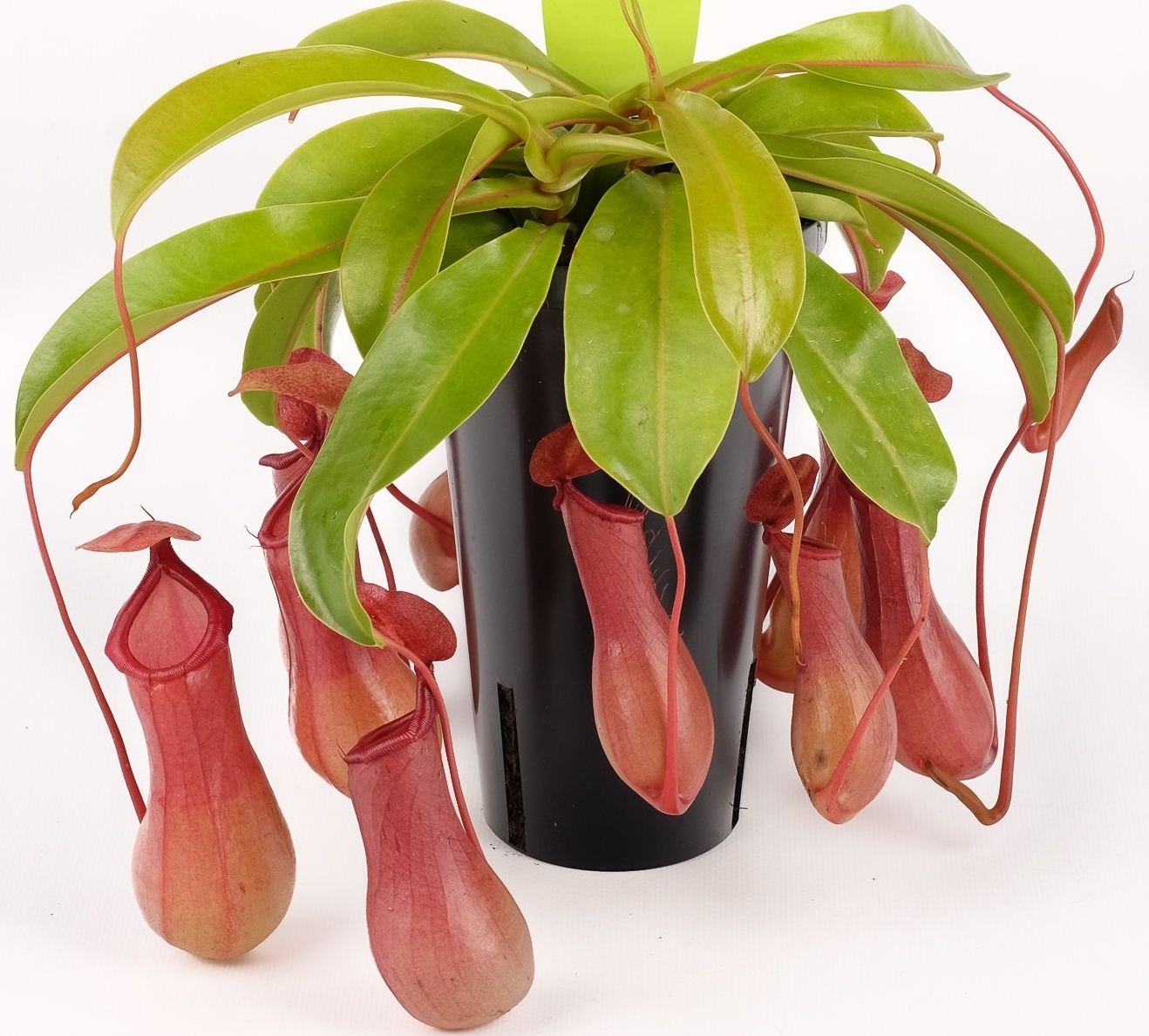Are pitcher plants poisonous to cats or dogs?
Carnivorous plants are one of the coolest houseplant options out there as they are not only beautiful but have a fascinating purpose. One of the most popular carnivorous plant species available today is the pitcher plant.
These amazing plants trap and digest many of the bug annoyances that homeowners deal with like flies, gnats, spiders, and more. But what about pets – are they safe around pitcher plants?
Are pitcher plants poisonous for cats and kids? Yes, pets can eat plants, like venus flytraps, sundews, and other houseplants.
Cats are not known to be poisoned by pitcher plants. Despite the fact that some Asian pitcher plant species can give cats digestive problems if consumed by cats, none of the commonly propagated carnivorous plants are thought to be particularly toxic to cats.
Of course, the majority of people are more worried about their cat or dog’s health than their nepenthes. Therefore, you shouldn’t be as concerned about your pet as you should be about your nepenthes!
Are Pitcher Plants Safe for Cats?
Cats can pose a serious threat to your nepenthes. You should be more concerned about the health of your plant than the health of your cat. Cats are not poisoned by pitcher plants, but cats can be very dangerous to your plant. Here are a few possible explanations for why your cat might be drawn to your nepenthes.
- You’ve probably heard the saying “curiosity killed the cat” before. Yes, on occasion curiosity is the only reason they are bothering your plant. They just find those dangling pitchers too annoying!
- In order to aid in digestion, cats frequently consume plants. Sometimes they are drawn to plants in general rather than your pitcher plant specifically. The plant’s excess fibrous matter can encourage vomiting. Hold on to me here. Cats instinctively know to eat fibrous foods to help them if they feel like they are about to pass a hairball and can’t get up.
- Science can sometimes explain why cats behave in certain ways, but not always. Cats are unpredictable and may be bothering your plant merely out of curiosity.
Also read our guide Sarracenia – The Pitcher Plant – Best Review
Keep Your Cat Away From Your Nepenthes
Cats occasionally just like to create chaos. Let’s discuss some strategies to help prevent your cat from accessing your nepenthes pitcher plants. Let’s hope we can find a solution!
Protect Your Plant From Your Cat
Put your nepenthes behind a cover; this is one of the simplest ways to protect it. Look down at the mesh cover you can use to place your plant in to help deter the cat. This should work if you combine it with some of the other strategies listed below!
Deter Your Cat
Your cat might chew on your plant even if they don’t eat it. It can be just as harmful to chew on as it is to eat. This frequently results in your plant dying or suffering significant damage. You might need to devise a strategy to stop your cat.
You can purchase some natural pet repellents, but they don’t appear to be very effective. Take some vinegar and mix it with some water as a natural remedy for this. Your plant will be safe from harm, but your cat will detest it. Even though there will be a vinegar smell, a damaged plant is preferable.
The other problem with this method is that you will have to replace the liquid every couple of days. You might want to make a big batch of it and have it in a spray bottle ready to go.
Discipline Your Cat
With a little bit of perseverance and tough love, you can probably find the best solution to this issue. When you notice your cat interacting with your plant, try to be present and discipline them.
The trusted spray bottle is one of the best techniques. Simply fill a spray bottle with a little water, and when your cat approaches your nepenthes, spray it briefly. After a few times, the desire to slap those pitchers should be outweighed by the fear of being sprayed.
Additionally, whenever your cat approaches your nepenthes, you can make a noise that your cat detests. A shout, a hissing sound, or a clap can convey your unhappiness to your cat. They will eventually associate your plant with these noises and stop bothering it if you do this frequently enough.
Prevent Kitty Boredom
Your cat is probably bothering your indoor plants most of the time because they are bored. When they don’t have anything else to do, they will look for entertainment. Maintaining your cat’s interest can occasionally be difficult with a job, kids, and everything else.
You can buy your cat some toys or a new scratching post. the one that is below! Providing your cat with something to do could solve the problem!
Plants Your Cat Loves To The Rescue!
Giving your cat some plants they would prefer over your nepenthes pitcher plant is another option for a solution. There are a few wonderful options available that cats adore.
Catnip is likely the most obvious ingredient here. Did you know you could grow catnip as a plant? To keep your cat busy, place a pot of catnip away from your nepenthes pitcher plant!
Click here to get some catnip seeds and grow your own plant!
To keep them occupied, cat grass is an additional choice. Cat grass is excellent for providing cats with an indoor equivalent of outdoor grass. This can keep them entertained and give them something to do! For more fiber, cats also enjoy eating grass. Cat grass is great for a house cat, whether you use it to scare away cats or just keep some around.
Tips To Keep Your Dog Away From Your Nepenthes
Nepenthes are non-toxic to dogs, so now that you know this, you’ll probably want to figure out a way to keep your dog away from your pitcher plant. Let’s look at some wise actions that will help keep your adorable dogs and your nepenthes pitcher plants separate:
- Nepenthes should be kept up high in the hanging planter. They won’t be able to get to them if you keep them up and out of the dogs’ reach. Click here
- When you notice your dog playing with your plants, discipline him. Dogs can detect tone, which I realize some people find difficult to accept. When they touch your plant and hear how unhappy you sound, it might influence their behavior.
- You can use a chemical deterrent to help keep your dog away from your nepenthes pitcher plant, though it wouldn’t be my first choice.
- Try to keep your plant out of the dog’s reach if at all possible. Hopefully, you can find a location to keep your pitcher plant away from your dog, whether in a different room of your house or in a different area of the yard.
I don’t believe your dog will pose a significant threat to your nepenthes, for the most part. The cat is typically more difficult to keep away from your plant.
Are commonly propagated carnivorous plants Toxic To Dogs Or Cats?
No, they are not, as was already stated. At the very least, nobody has ever reported that. I searched everywhere and read through several forums in an effort to find any reports of nepenthes plants harming animals.
I was able to access the ASPCA website and conduct a search there as well. There was nothing for a pitcher plant or nepenthes there that I could find. You can visit the website for yourself by clicking the link below.
To see if any of your plants are poisonous to your pets, click on the letters below and narrow your search to just dogs or just cats. There is no carnivorous plant to be found anywhere.
ASPCA Poisonous Plants For Pets
It would probably be best to see your veterinarian if your pet ate a nepenthes and began acting strangely. Make sure to get in touch with your veterinarian right away if you notice any of the following.
- vomit or have diarrhea
- on the skin or in the mouth, redness, swelling, blistering, rawness
- sluggish behavior, or an abrupt collapse.
Contact your veterinarian right away if you notice any of these following your cat or dog eating a nepenthes.
What to Do If Your Cat Eats Your Carnivorous Plants
As we’ve already covered, pitcher plants are safe to consume and are not known to be poisonous to cats. They should not, however, be eaten because that is not their intended use.
You might want to watch out for symptoms of digestive problems if your cat eats a lot of your pitcher plant. Even though the plant is not poisonous, different pets may react differently to it. If you notice the plant has been eaten, some indicators to look for are:
- sudden collapse or unusually sluggish behavior
- frequent nausea or diarrhea
- excessive irritation characterized by skin or mouth rash, swelling, blistering, or redness
- reduced thirst or appetite
If you notice any of the above symptoms, you need to call or visit your cat’s veterinarian immediately. Even though these plants shouldn’t regularly cause vomiting or diarrhea, they should be treated if they do. Additionally, you should be aware that it may take a few days for your pet to exhibit any adverse effects of plant digestion.
You should take a piece of the plant or its label with you to the veterinarian. By doing so, they will be able to more accurately diagnose your pet’s problems and determine how to best treat them. They are not poisonous, but your veterinarian may still need to give medication or give liquids to prevent dehydration.
If you notice these symptoms after hours, you can contact your nearest emergency clinic for help. There hasn’t been a case where a cat was killed or seriously hurt by a pitcher plant, but that doesn’t mean it can’t happen. Additionally, you can get more advice on how to care for your pet by contacting the ASPCA Animal Poison Control Center.
Do Nepenthes Make Good Houseplants?
Now that you are aware of the complete safety of pitcher plants. It’s time to think about growing them at home.
Pitcher plants make great indoor plants for a variety of factors. Observing such a unique plant, which not many people have in their homes, is merely fascinating. They function as bug controllers and display fascinating insect trapping mechanisms.
When you have a pitcher plant, you can watch as insects are drawn in by the fragrant nectar and fall into the pitcher. Then, due to a variety of features on the interior wall of the pitcher, such as thin hairs pointing downward and inward, the insect is prevented from crawling out again, effectively trapping it.
As a result, they are encased in digestive fluid at the bottom of the pitcher where, after a few days, they become ingested and transform into a gooey, soup-like substance from which the nepenthes draws the nutrients it requires.
Bug control is one of the aspects that make pitcher plants and other carnivorous plants so attractive to many fans of house plants. They can, for example, digest gnats, spiders, flies, and other small insects.
It won’t likely be necessary for you to feed them if you place them in an area where insects tend to enter the room, such as on a window sill or close to a door.
However, you might need to give your nepenthes food if there are no insects at all in your apartment. In this situation, you can try to hunt down some insects on your own, but if that proves challenging, purchasing goldfish flakes from a pet store is another option.
You might be tempted to let your pitcher plant join you for lunch or dinner, but you must resist this urge! Never give them human food or chunks of meat because they can’t process it.
The location of your plant should be warm and humid. Chose a bright place that receives at least six hours of direct sunlight a day. They thrive best in temperatures between 60 and 85 F.
Pitcher plants grow best in soil that is poor in nutrients. A mixture of moss and perlite works well. Refrain from using potting mixes or fertilizers. Keeping the soil moist is essential throughout the growing season, which lasts from May to October. But don’t just pour water into the pitchers!
Some pitcher plants enjoy going dormant in the winter, which is akin to the hibernation we are familiar with in some animal species. Three to five months may pass during this period of dormancy. The plant does not need light at this time and is content in a cooler, dryer environment. Mulch should be spread over any pitchers that are just beginning to develop.
Once you have chosen the species of pitcher plant you want, you should research its requirements during the winter since not only do their periods of dormancy vary in length, but some of them continue to grow instead of going dormant, necessitating more care than during the summer.
There are several nepenthes species that can be grown indoors. They produce lovely pitchers that range in color from light green to dark maroon and can grow up to 20 or even 30 cm long, depending on the species, location, and care. Everyone is sure to find the ideal species among the wide variety of pitcher plants for their environment and potential.
In Conclusion
Even though you can be sure your cat won’t pass away, you should still prevent it from eating your pitcher plant. You should discourage your pet from eating any of your plants. Make sure it’s catnip or kitty grass if your cat must nibble on something green because they’re both considered safe treats.
